
Greetings Fresh Loaf
Well it's about time....
I have been a long time reader and have learnt so much from various bloggers/posters and now I think its time I joined in. Thank you Debra Wink, proth5, TX farmer, DMSnyder, Ananda and Hans Joakim for your inspiring and educational posts.
I guess for my first post I'll show where I am at....
A month ago my new Komo Fidibus XL turned up and I have graduated form being a home baker to a home miller/baker. I love it.....I mean I really love it!
I usually bake once a week (used to be alot more...I am relaxing into it now) I have a "desem" style starter that lives in my fridge @ 60% hydration which gets expanded twice in a cool spot under the house before use...its happy. I used to be a neurotic culture carer...my current method works and gives us beautiful bread.
Yesterday was a biggish bake....family coming on the weekend and lots of kids staying for a week....they will want to be fed.
1 x Miche @1.8kg (Sifted wheat, whole spelt and rye)
2 x Wholewheat sourdoughs @ 1kg each
2 x Wholewheat raisen and coriander (From Tartine bread) @ 1kg each
Wholewheat Sourdough
Wholewheat Crumb
Raisin and Coriander Wholewheat
Miche
Last week Desem's
I love using the fresh flour. I have sourced my grains from two organic millers in Australia (one of them is biodynamic). Kialla is a organic miller just a few hours away who's flour I have used for a few years now. I use there grains for the majority of the doughs (It is strong and thirsty). I build/feed the levain with grain from Four Leaf biodynamic mills in South Australia. I have found there flour softer but more flavoursome.
Was wondering if I would miss white flour...this has not been the case at all. The Raisin and coriander bread was so amazlingly soft...melted in the mouth. All the breads had a mild flavour, no sourness (prefer it that way)
Have not cut the miche....giving it a day or so until the family arrives....should be just about right then I reckon.
Well that's it for my first post.
All the best
Phil
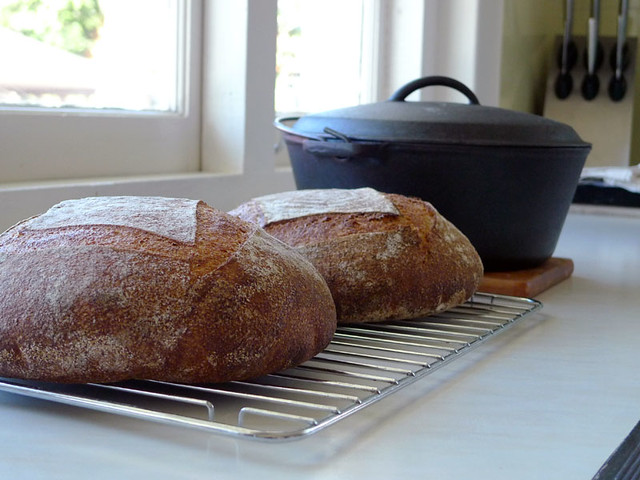
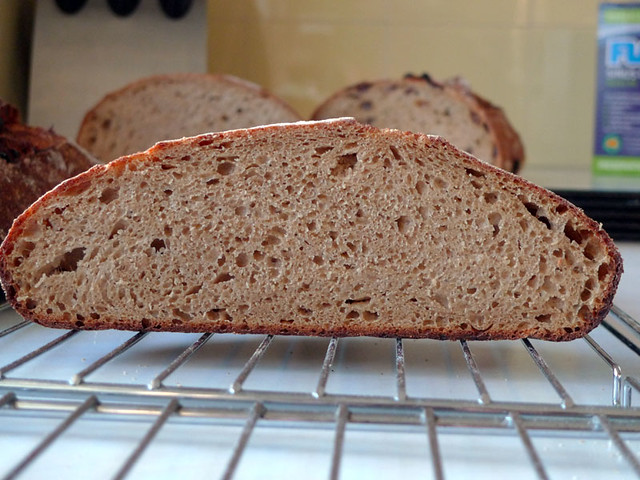
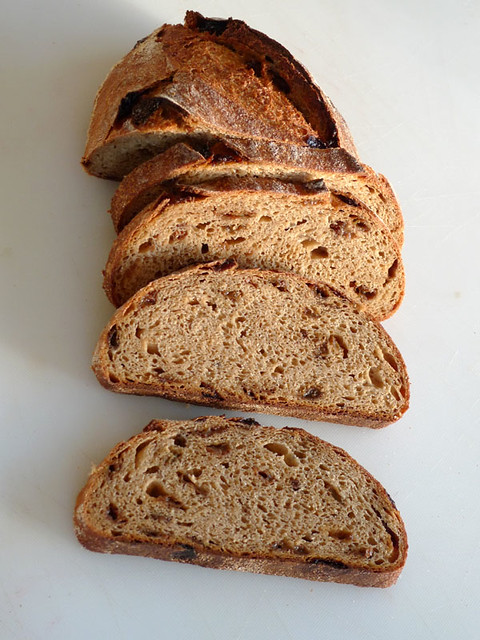
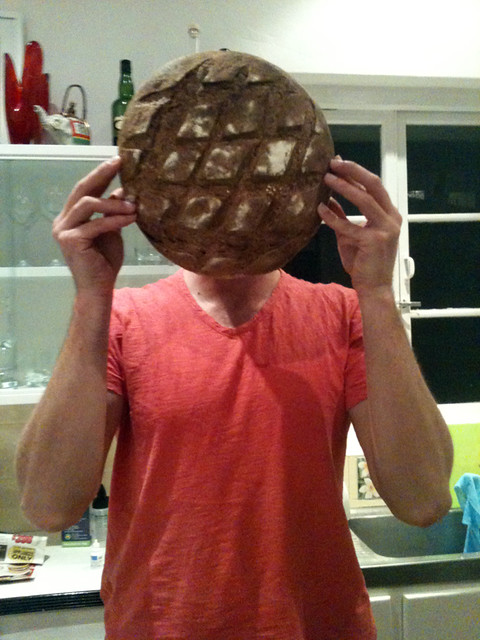
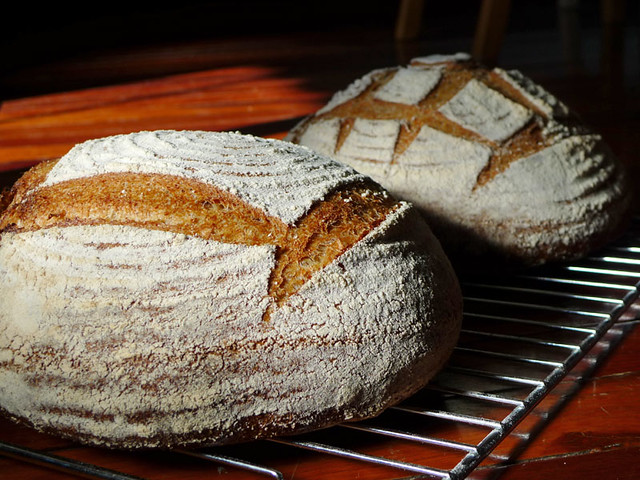


Comments
Hi Phil
Welcome to TFL.
Lucky family!
Have you explored your fellow Brisbanite Shiao-Ping's blog? She posted in a comment on her visit to the Kialla Mill. I see their flours in tiny cotton bags (1~2kg) here in a few health food shops but am never tempted to buy it, it's very, very expensive and I aways wonder how long it has been sitting in less than ideal storage condition on a shop shelf. Great that you can buy grain from them.
Cheers, Robyn
Hi Robyn,
Yeah, I have read Shiao-Ping's blog, found some great local bakeries via her writings. Old bags of flour sitting for eternity in healthfood stores was a major push for me getting my own mill. It's funny though, when I was buying flour in bags, I would happily feed starters twice sometimes three times daily and discard without too much consideration...it came from a bag on a shelf. Now that I have started milling, I find that harder to do, I am one small step closer in the chain I guess and I now see the waste.
cheers
Phil
Welcome Phil,
Your loaves look great. I especially like the look of the desem.
Out of curiosity - what is the temp. under your house? I, too, keep a desem but keep it at about 50-55% hydration in the refrigerator and when I am going to bake I simply take about 10g of it and build a leaven from there but the temp. in my house is about 75° now - it will get cooler in the winter - and I still get a mild sour at that temp.....I also do more frequent feeds before using.
I also have a KOMO and LOVE it! I had a Nutramill first but got tired of having to take it apart to clean it after each use. It had to get repaired and I knew I couldn't last without a mill for 2 weeks so I started shopping around and knew I had found what I wanted when I saw the KOMOs. My Nutramill is now stored in the basement and comes out only when I need to grind corn or dried beans.
What settings do you usually use on you mill?
Thanks for posting your photos and introducing yourself.
Janet
Hi Janet,
thanks...
Temperature is hovering around 18°C (66°)...but...we haven't hit the height of summer yet....may have to revaluate then.
My partner and I decided on the Komo over other models which I could have received quicker/cheaper...was a major test of patience for me waiting for shipment. It is so beautifully made. I have been placing the grain I want to grind in the fridge a day before use to help keep flour temperatures down. When milling, I wind it down till the stones touch then back it off about a finger width, maybe a little less if I am not sifting. I have the XL model so I am not sure if that distance is the same for you.
Cheers
Phil
Hi Phil,
Ours grind the same way. The outer is design is all that is different. The distance with the stones change whenever you take apart the mill. I took mine apart to see what the stones looked like and when I re-assembled it I noticed that the grinding sound began at a new '•'. Just all depends on at what point I begin to screw the top hopper back on.
I manage the temp. by putting the ground flour into the refrig. after I have milled it. I mill several times a day when baking due to leaven builds and I always have a couple of recipes going at once. With my old mill it was a hassle - so much extra work. With this one it is soooo easy - especially with no clean up. I do throw a towel over the shoot when grinding so that the dust doesn't end up all over the place - not that it throws out a lot of dust but it does build up so the towel minimizes the mess.
I agree with the beauty and I love the simplicity and the fact that I can take it apart to clean and repair very easily. I was lucky when I ordered in that the company I ordered from is in Nebraska and I am in Colorado. It got here in 2 days!
Thanks for telling me the temp. at which you keep your starter. When you are doing builds for a bake how do you do your builds (proportions of flour to water to initial seed amount.) and how long does it take? (At the temp. here I can get all 3 builds in in less than 12 hours. If I was doing it at your temp. it would take much, much longer as the cool temps. really slow down the fermentation.)
Take Care,
Janet
2 DAYS!!!
I bought directly through Komo in Germany as we have no suppliers who keep them in stock....took about 2months to arrive...I was a little stressed.
My builds really depend on temps and time. At the moment which is ideal temprature I am using a (1 : 1.2 : 2) ratio. About 12 hours later and it is just nice...smells sweet. If I was keeping it warmer I would just drop the seed ratio down...I have used .5 : 1.2 :2 in summer or use it earlier when I can't control the warmth.
I am not game to take the mill apart yet...been using a coarse grind and a vacuum to clean it....works great.
Cheers
Phil
Hi Phil,
Yes, I consider myself fortunate indeed!
Do you use your freshly ground flour for your builds?
If I were to use your ratios with my freshly ground flour my starter would double in 3-6 hours when left at 70° -75°F/21°-24°C! I tried keeping my starter on the counter all the time last winter and I could never get it adjusted correctly so I went to making up a bunch and storing it in my refrig. and taking a bit out of it when I am going to bake and building off of that amount - usually a couple of builds until I get the amount I need. Much less waste than trying to keep it out all the time.
I was hesitant to try taking my mill apart too so I called the company I purchased mine from and talked to someone who had one; she relieved my fears. I had a friend here when I took mine apart to help if I couldn't remember how to re-assemble....didn't need help. It is beautifully simple and I encourage you to give it a try. All you do is unscrew the hamper. Turn towards 'grub' and keep turning like taking a lid off of a jar. It will come to an end and then lift off. Bottom stone can't be removed so all you are dealing with is one stone that can only be taken off and put back on one way. Very simple....nothing else is involved. You will be pleasantly surprised!
Putting it together is easy - just screw the hamper back on and when it begins to tighten up do your test to see at what point the stones start to grind together. Just turn it on an off as you adjust. Pure genius in the design.
I use my mill several times a day so all I do to clean it is use a pastry brush to brush out the shoot. Easy-breezy....I have never used a vacuum. If I am worried about 'gunk' on the stones I mill some brown rice which I then use to flour my baskets. Nothing could be easier - and so efficient!
If you give it a try - let me know how it turns out....
Take Care,
Janet
Hi Janet,
I am using fresh flour for the builds. The grains are kept in the fridge before milling and I am using cold/cool water so the final dough temperature of the levain is where I want it to be. So far it has not over fermented amd smells just lovely, with only the smallest sign of collapse. In summers past I have used a small proportion of salt in the builds (.5-1%) to control them as the humidty and heat would turn them to slush.
I reckon its good practice to watch starters on a bench when people are first starting out so they learn how they work.....
Cheers
Phil
Hi Phil,
I will have to give your method a try. I had forgotten about the salt 'trick'.
At what specific temp. are you aiming when you do your builds for your final doughs? Is that different than the temp. you mix when doing a feed without a build for use?
Do you ever store your starter in the refrig?
Thanks,
Janet
Hi Janet,
My usual process looks something like this....
The desem ball lives in a jar of flour in the fridge for the week.
On Friday morning it is removed and fed with the following ratio 1:1.2:2 (45g starter: 54g water: 90g flour) and kept at 18°C (64°) for 12hrs. It is refreshed again that night with the same ratio (190g starter: 228water: 380g flour) Satuday morning I will have enough starter for a variety of breads...and enough to build a new desem ball (around 15og) which is placed directly in the fridge in a jar with room temperature flour around it (room temp flour slows the cooling process and gives the starter a chance to start to develop before it gets too cold).
So for the builds I am aiming for a cool temp....the final dough is a different story. It varies on the formula.
My desem formula's DDT (desired dough temp) is roughly the same temp as the builds, but other formulas I use (ie Tartines) use a warmer dough temp.
Hope it helps.
Cheers, Phil
Hi Phil,
It helps a lot. I always thought a desem ball was kept in 10 lbs of flour in a very cool basement....nice to know it can live in the refrig. I will have to give one a try!
Does your starter have more of the mild sour due to your process?
Another question:
Let's say you have all of your freshly fed starter ready to use and you only have time to mix up a couple of doughs on Sat. Would you then just put the remainder of the starter into the refrig. 'as is' to be used on Sunday?
Thanks,
Janet
P.S. Where did you find out about how to create, store and use a desem? Only source I have found is Laurel Robertson's book - 'Bread' and it is different from your technique.
And one more question: Since I bake daily with my SD would I simply take a piece off of my desem ball (when I make one) that I will store in my refrig. and elaborate as needed for the day's bake? (I now have stored starter - similar to your desem ball -just not surrounded in flour - and I take about 10g out and do my builds from there based on how much I need for a specific bake.)
I have a couple of books where I picked up bits and pieces. Thom Leonard's "Bread Book" is a good one but he uses volumes instead of weights, but its written in a way that you start to feel and understand the processes. The "Bread builders" has a nice section that explained Alan Scott's method for baking desem. I also have Laurels' book and probably refer to that the least as I find the process very long winded.
I think Thom's book mentions using the fridge which for me has worked really nicely. He suggests feeding it twice a week if kept in the fridge...mine is doing
OK with its weekly builds.
Its my Saturday morning routine now to mill/bake. I try to use any excess starter if possible, or do smaller builds if I know i'll be needing less.
I find the desem bread flavour very mild but certainly not bland...The same starter using a different formula and flours (Spelt/rye) can produce a lively tang if I want it to.
If you are baking daily with your desem I wouldn't really bother with the fridge....just try and find a cool spot or do builds with smaller feedings.
I haven't really used the fridge other than for proofing/retarding bread and long term starter storage.
How is your bread turning out?
Your lucky to be baking daily....wish I could, would stop me thinking about it :)
Phil
Hi Phil,
Baking daily doesn't stop me from thinking about it .....It is always on my mind :-)
THanks for the desem info. I did some reading here last night on the topic and I am thinking that the starter I have going now is very similar to a desem. One definition of a desem was that it is simply a sd starter made with all ww flour...
My loaves turn out well and I am finding out how to work with my starter so that it is more on the mild side. Most people I give loaves to are surprised to find out I use sd as a leavening agent.
One of the techniques I have been working was told to me by D. Wink....involves more frequent feeds and less food per feed. I have yet to figure out how to do that when I am asleep (Most of my builds ripen in less than 4 hours) so I haven't tried keeping any out on the counter yet but am working towards that end BUT when I used to keep it on the counter I had a lot more waste. Now I have none. I take out a bit from my storage starter every morning and feed it 3x during the day so I can mix the final dough in the evening and then let it retard overnight in the refrig. Maybe once I feel more settled in what I am doing I will try again.
Don't think I will try to do the desem starter. Keeping one going is enough for me and I would be torn between which starter to use and then waste would end up happening again.....I began thinking about that last night after toying with the idea...(I actually have 2 starters - a rye one and a wheat one and they keep me busy enough...)
I don't know if you have checked out any of txfarmer's formulas but she has some wonderful ww ones that she is able to manage baking on a very busy schedule by spreading things out over 2 days. Each piece only takes a few minutes of time before the dough is left alone. Many here have learned how to use time and temp. to work with their busy schedules. Refrigerator comes in handy!
THanks for your response to my questions. I look forward to seeing more of your loaves appearing here now that you have taken the plunge :-)
Take Care,
Janet
From my understanding a "desem" style starter requires feeding with WW flour, fresh milled if possible and cool temperatures. I think the cool temps are the most important, but the fresh milled certainy makes its mark. I think I have kept every style of starter under the sun and had many on the go at once...exhausting :) As you mentioned the frequent feeds do help with mild flavours (yep, tried that method as well) and I have had beautifully risen bread doing that ... Just feel very tied to the bake doing that.
Its probably not necessary to keep another desem starter if you are happy with your other two starters...just do a few builds at the lower hydration in a cooler spot with WW and your well on your way to great bread.
For me my current process feels so much more relaxed...I just don't have the convenience of throwing together a loaf at will...a touch of planning is now required and I just adapt formulas to use my style of starter if required.
I am keen to experiment with a bulk retard on some wholewheat loafs one day...too many options :)
Cheers, Phil
Phil,
Thanks for your response.
Bulk retarding is great. Leaven build in the moring. Evening mix final dough with a couple of S&F's and then into the refrig. till morning. Shape and more sitting while proofing and then bake :-) Tis a very relaxed method and I find Peter Reinhart's formulas out of 'Whole Grain Breads' and txfarmer's ww adaptations from Laurel's book are great this way. I now adapt most recipies I like not to these methods. Nice soft crumb with the whole grains having a lot of 'wet' time.
I hear you about all of the options.....gradually I think we all find what suits each of our life styles the best. Having this forum has opened up many options I never would have stumbled across on my own. Overwhelming at first but now I am beginning to get a better picture of things.....phew :-)
Take Care,
Janet
Lovely looking bakes, PiP! well crafted.
I own a HAWOS - easy mill, kind of akin to Fibidus mills in bein german. I noticed that even when the setting is on the finest mill, flour still does contain midllings. I solve that by doing 2 passes, one that reduces the grains to shreds, and the second mills them to fine flour.i refrigerate the shreds for later final milling. This way, i eliminate most middlings, and get very fine flour, which helps loads with the final crumb structure.
All the best,
Khalid
Thanks Khalid,
I've not tried doing multiple passes other than remilling some bran/germ after sifting. Guess I have been worried about raising the flour temperature too much. I have only been sifting occasionally for specific loaves. I have been really surprised how light and soft the wholemeal breads have been.
Are you milling before mixing or letting the flour cool before remilling and mixing doughs at a later time?
Cheers, Phil
Hi, Phil
I mill wheat to to shreds, then refrigerate it for the time i wat to mill into flour,this could be days. On milling day, i take the shreds from the refrigerator and mill them to the finest setting. When flour is ready, i allow it to cool for 1 hour at room temp. then use it or refrigerate it.
Hi Phil,
and welcome to TFL :) I just found this post of yours. I've never tried the desem method but it would/could be another interesting bread 'project' (as if i needed another one...). To save me from spending hours online, let me ask you some very basic questions: does that mean you feed your desem starter with only ww flour? I can't get freshly milled flour but i can manage ww. Also just how much flour would your surround your desem starter with? And could you describe what happens to it while it sits in the fridge, as in, is there growth? change?
betw Janet baking every day (envy!!!!) and you three milling your own flour (more envy!!!), hats off to your dedication all of you. Beautiful breads!
ww,
I have learned from people here how to manage time in order to bake daily. Each step takes but a few minutes and then the dough sits - either on the counter or the refrigerator. A great trick :-)
Milling: I don't know where you live but if you are in the US there are many online sources where you can purchase a mill for under 300.00. (Nutramill is a biggie and Pleasant Hill Grains sells them and they are a GREAT company. I am not related to any of them nor do I work for them....just a satisfied customer :-)
I first purchased a mill when my kids were young about 18 years ago. I was able to buy organic grain in 50# sacks from a local grocery store. Homemade organic loaves of bread cost less than .75 so the mill soon paid for itself.
When I found this site about a year ago I resumed baking.....I had slowed down over the years as our life got more hectic with growing kids and all of their activities - not extra time to spend kneading dough and waiting for it to ferment. I discovered the Bosch mixer and the Peter Reinhart 'epoxy' method of working with whole grains. I was off and running and my old mill was replaced with a Nutramill. (It has since been replaced with a KOMO....cost effectiveness took a backwards step :-/ .
A 50# of grain still runs about 30.00. Organic loaves of bread around here cost about 5.00 a loaf so the savings more than covers the cost of a mill within a short period of time when people go through a 500g loaf a day :-)
So, it really isn't about dedication as it is a cinch to do. Whole grains store for ages so I have the added convenience of fresh flour whenever I want it! The word I would use to better describe my situation is that of being very 'fortunate' in that I have a local source for fresh reasonably priced whole grains and I had the ability to purchase a mill on line as well......
Good Luck with your baking :-)
Janet
Hi,
A desem starter would only be fed with ww flour, preferably fresh, at low hydrations and kept at cool temperatures. Really a desem is only another name for levain, starter or levean and is more of a description of how it is maintained.
After I have refreshed the desem with fresh flour and water I give it a few kneads on a bench till its fairly smooth (takes a while for flour to absorb all the moisture) round it in a ball then place it in a jar. There is a photo of the jar and desem about to be refreshed on this page http://www.thefreshloaf.com/node/25298/wheat-figs-and-anise
I fill the jar around the desem ball with room temperature flour (around and on top) and then put it directly in the fridge....it takes time for the fridge to cool the jar and flour in it and this allows the desem time to get a headstart before the cool temperatures slow it down. Much like leaving a starter on the bench for a hour before placing in the fridge I guess.
During the week in the fridge you can see cracks start to appear on the top of the flour as the starter starts to grow within it....after a week when the desem ball is removed it has a rind/skin around it, cracks and maybe a side starting to pop off.....inside the starter it soft, aerated and sweet smelling....dissolves easily when building/refreshing.
The desem starter works well for me as I bake only once a week using fresh flour and it lives very happily in the fridge betwen bakes...I also have a cool spot to refresh it even in summer.
cheers, phil
Dear Janet,
thanks for all the tips. You seem to be making exclusively ww breads?? That's so healthy and wholesome. And it must be even more fulfilling when you are able to source locally and eat organic. I have not gone down the milling road because although we eat bread daily, my parents (we're Chinese) are still partial to their rice and noodles and i can only allow myself one baking session per week (time permitting)! As it is, i clog up the fridge and kitchen with my baking paraphernalia, i cannot imagine the look of horror all round should i try lugging home sacks of flour!!
Phil: Desem sounds like a good idea in my very warm climate. Thanks for the advice. I will have to work around the 18 degrees proofing though cos no way i will ever get that cool temperature around here! Currently I use a 100% hydration leaven that i refresh two or three times before use over one/two days on an almost weekly basis. The downside is that my leaven is not absolutely stable, predictable because the refreshing schedule can vary (also depending on what flour i can get my hands on). The upside is there's always an element of surprise and I get a good sour. It strikes me that desem is like a very stiff and controlled leaven. I also like the flavour and smell of a ww-fed leaven.
Littel heavy on the dusting but still delicious...using
P1150745.JPG